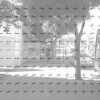Free Online Productivity Tools
i2Speak
i2Symbol
i2OCR
iTex2Img
iWeb2Print
iWeb2Shot
i2Type
iPdf2Split
iPdf2Merge
i2Bopomofo
i2Arabic
i2Style
i2Image
i2PDF
iLatex2Rtf
Sci2ools
ICCV
1999
IEEE
1999
IEEE
Manhattan World: Compass Direction from a Single Image by Bayesian Inference
When designing computer vision systems for the blind and visually impaired it is important to determine the orientation of the user relative to the scene. We observe that most indoor and outdoor (city) scenes are designed on a Manhattan three-dimensional grid. This Manhattan grid structure puts strong constraints on the intensity gradients in the image. We demonstrate an algorithm for detecting the orientation of the user in such scenes based on Bayesian inference using statistics which we have learnt in this domain. Our algorithm requires a single input image and does not involve pre-processing stages such as edge detection and Hough grouping. We demonstrate strong experimental results on a range of indoor and outdoor images. We also show that estimating the grid structure makes it significantly easier to detect target objects which are not aligned with the grid. Proceedings International Conference on Computer Vision ICCV'99. Corfu, Greece. 1999.
Computer Vision | ICCV 1999 | Manhattan Grid Structure | Manhattan Three-dimensional Grid | Proceedings International Conference | Single Input Image | Strong Constraints |
| Added | 15 Oct 2009 |
| Updated | 31 Oct 2009 |
| Type | Conference |
| Year | 1999 |
| Where | ICCV |
| Authors | James M. Coughlan, Alan L. Yuille |
Comments (0)

